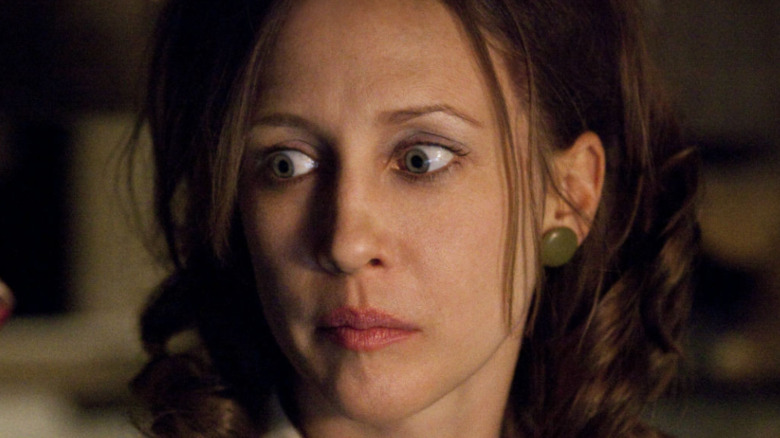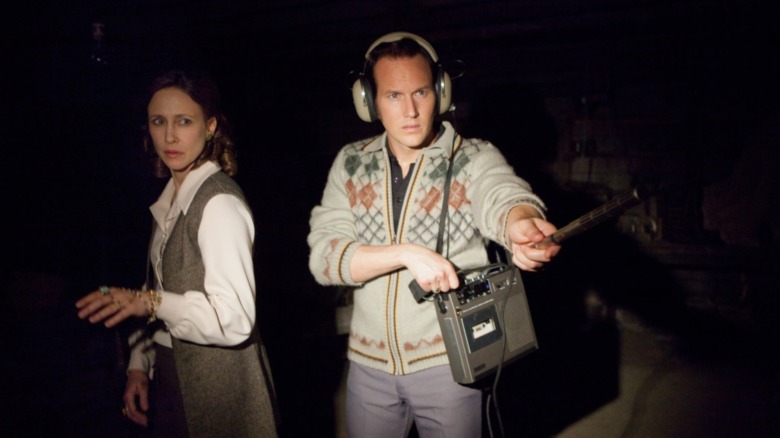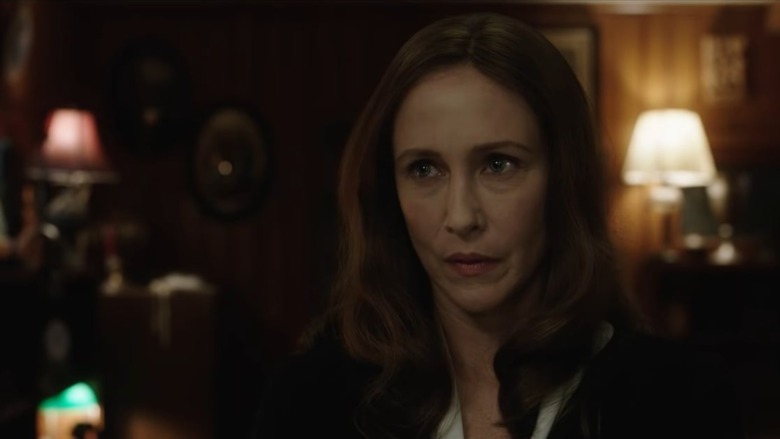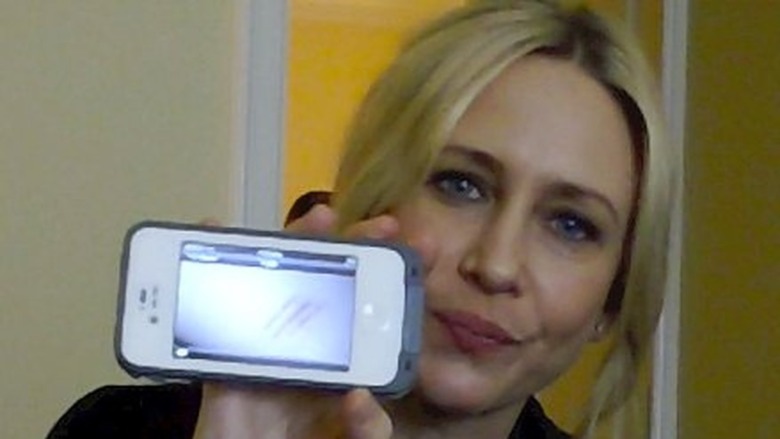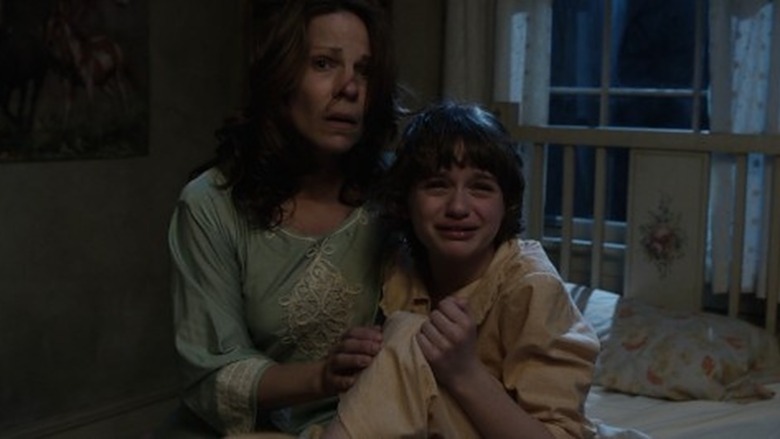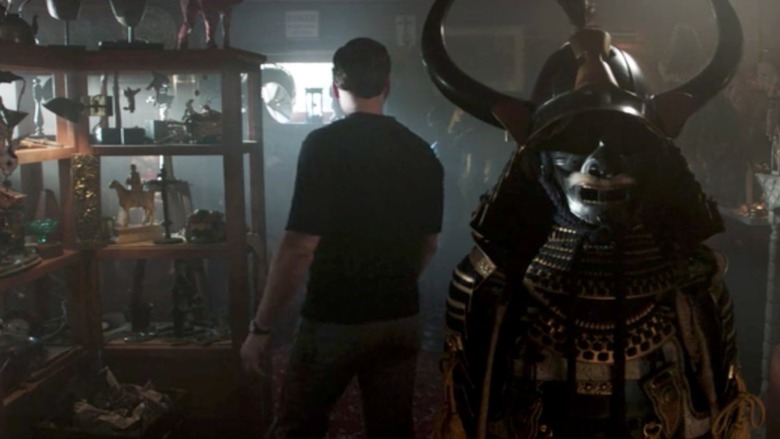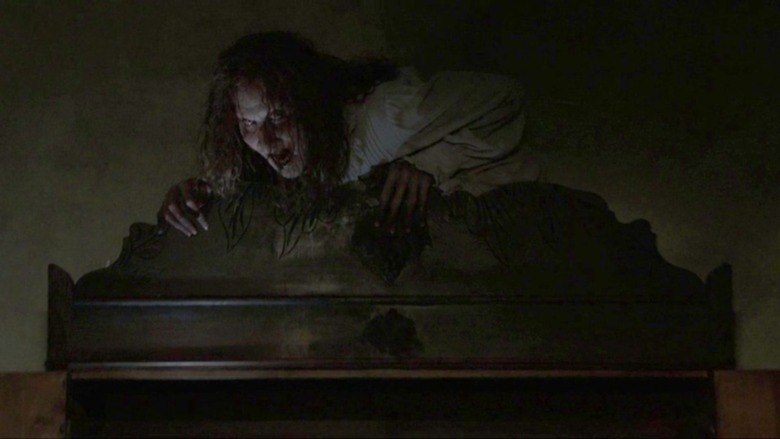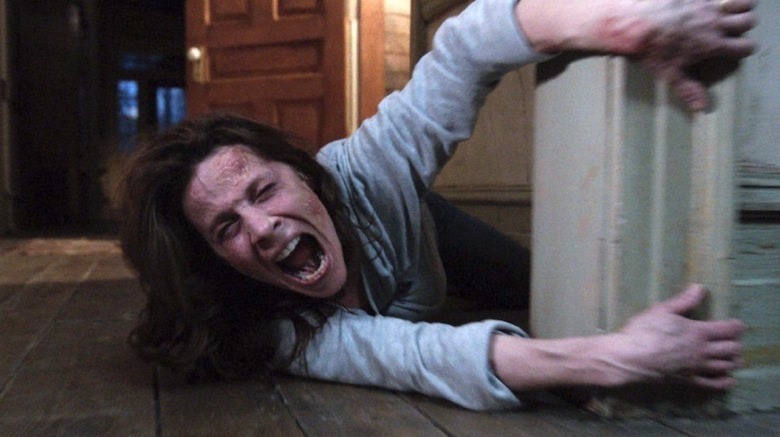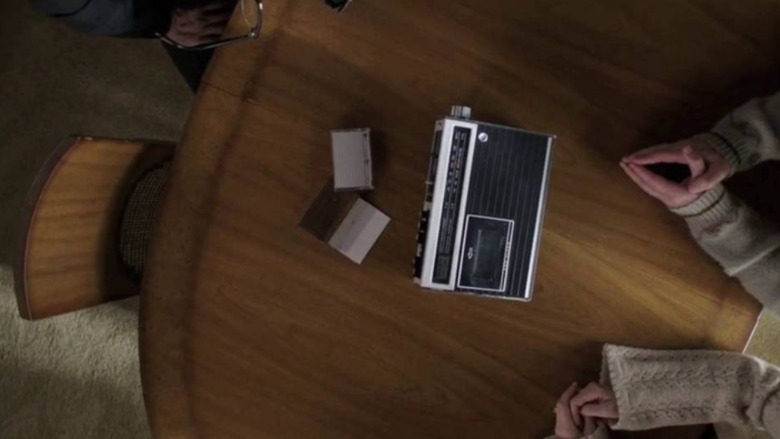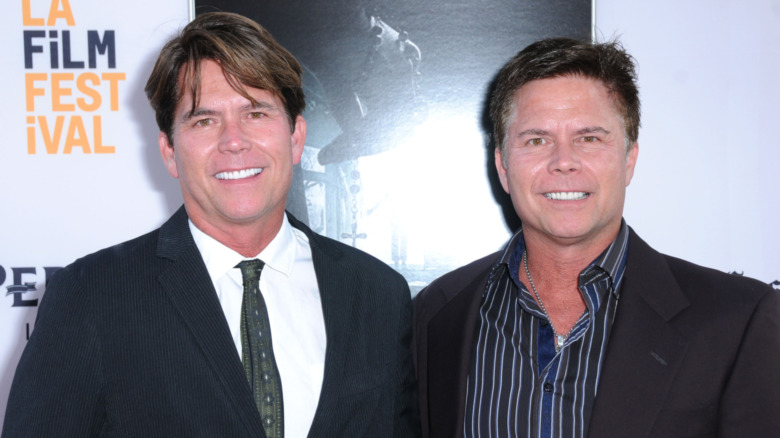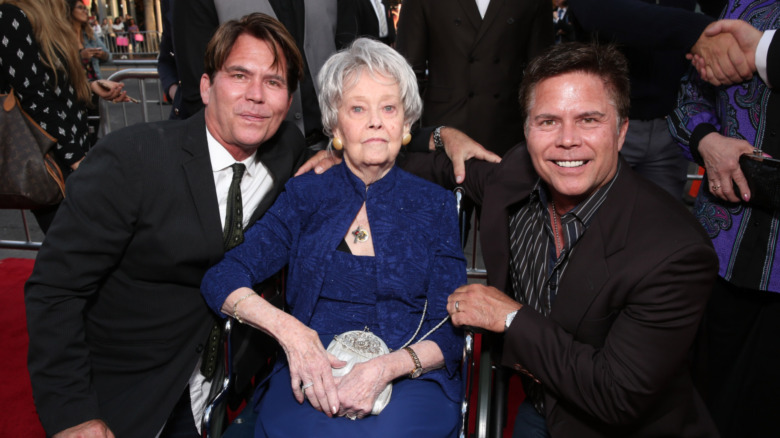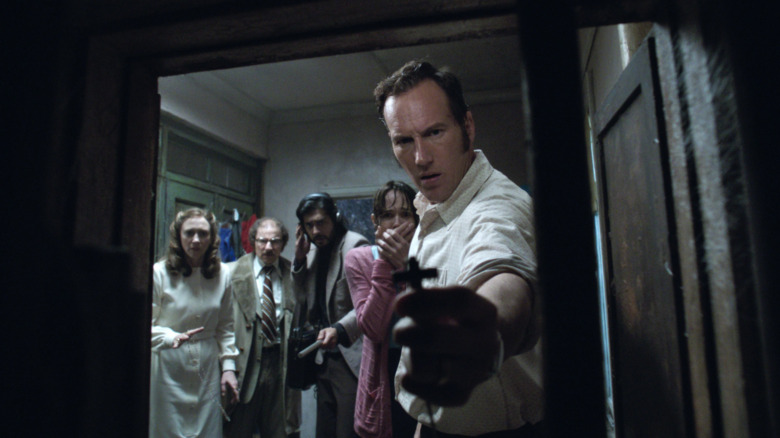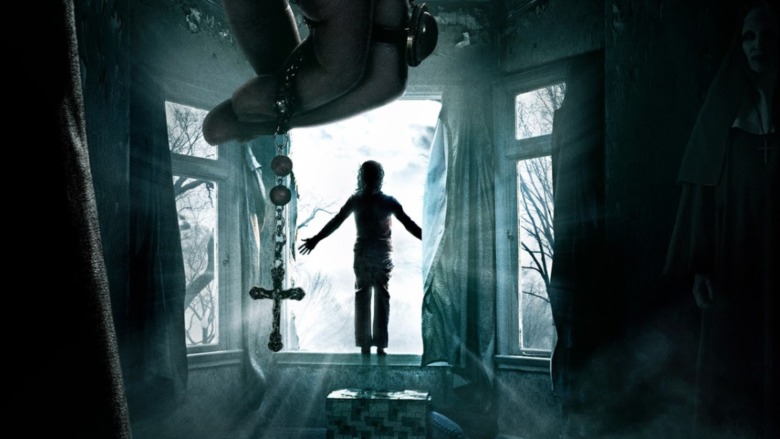Bizarre Things That Happened On The Set Of The Conjuring
A lot of people are a little superstitious. We might not all carry around a shaker of salt to throw over our shoulders, but most of us can likely relate to hearing old sayings, maybe from our parents, running through our heads when certain things happen. A red sky in the morning might make us expect bad weather or even unfortunate events ("Red sky by night, sailors' delight; red sky by morning, sailors take warning").
We all have lucky numbers or lucky sweaters, and little idiosyncrasies we've picked up from our cultures, families, and experiences. And even if you wouldn't classify yourself as overly superstitious, you might get a little nervous if you found yourself in a place that was notoriously haunted. And the set of a horror film allegedly based on a true story? That's enough to give pause to even the most stoic among us.
For a fictional film that sprang out of a true story, "The Conjuring" spawned quite a few real-life scary stories of its own. The 2013 horror film wasn't just a ghost story: By many accounts, the "spirit" of the story really came alive on set.
A spiritual setting
Just as it's not a typical horror film, the inspiration for "The Conjuring" was also not the traditional story. Most fans of the horror universe know that it's based on the real-life case files of Ed and Lorraine Warren, the husband-and-wife paranormal investigative team who rose to prominence in both the paranormal and entertainment worlds.
The writers, directors, and producers on "The Conjuring" and its sequels consulted extensively with the real-life Lorraine Warren until her death in 2019 (sadly, Ed Warren passed in 2006 before he was able to see the film adaptation of the Perron case). What's fascinating is that this story in particular, out of all of their cases, had a profound effect on the Warrens themselves: The late Ed Warren himself insisted to producer Tony DeRosa-Grund that the first film made explicitly about his and his wife's investigations be based on the Perron case.
There are other films, like those based on the Amityville haunting, that are indirectly inspired by cases the Warrens have investigated, but none of them had yet focused so specifically on the investigators themselves as main characters along with the families experiencing the hauntings. The Perron case clearly carries a great significance and left quite an impact on the Warrens, just as it would on its cast, crew, and audience. This particular set likely brought some palpable spiritual energy with it.
Vera Farmiga certainly felt that presence
The actors who played the Warrens were strongly affected by both the Perron case and its dramatization, just like their real-life counterparts — and not just because it spawned a successful film franchise whose universe is still growing today. No, there were some things that happened during the production of "The Conjuring" that were too creepy to be coincidence.
Vera Farmiga, for example, portrayed Lorraine Warren, who professed herself to be a clairvoyant medium. Lorraine's intrinsic connection to the spiritual world seems to have rubbed off on the actress who portrayed her, because Farmiga found herself mysteriously and repeatedly waking up between 3:00 and 4:00 in the morning on set.
It's jarring enough to note that this time frame is commonly known as "the witching hour" or "the devil's hour," a time of night associated with heightened supernatural activity due to the belief that witches, ghosts, demons, and the like reach their greatest power during this window and that the line between life and death, physical and supernatural, is at its thinnest.
But it gets even creepier than that. In this particular film, the specific time window in which the witch character died was during this "witching hour." Farmiga was so shaken by the experience that it was she who pointed out to the director the uncanniness of this connection. The actress's sleep troubles persisted even after the movie wrapped.
The mysterious claw marks
In addition to sleep disturbances, Farmiga also dealt with mysterious claw marks that seemed to follow her wherever she went, even transcending both physical and digital barriers. The first time she encountered a set of three mysterious claw marks, they appeared on her computer screen, an interesting choice for a spirit to reveal itself.
She had been working on her laptop, then closed it normally to take a phone call about being in "The Conjuring," a phone call in which she expressed both her interest in the project and her desire to have Patrick Wilson play the part of her husband, saying that if he was in, she was in. When she opened her laptop again, she found three diagonal, digital claw marks descending from right to left.
Later on set, she again discovered three claw marks, but this time they cropped up much closer to home: The marks now appeared on her thigh. That was the last time they showed up, thankfully. And Farmiga did admit that the claw marks that appeared on her computer were slightly different (a little thicker) from those that appeared on her leg. But maybe all that means is that there wasn't one supernatural force after her, but two.
Bruise it or lose it
Speaking of bodily marks: Joey King, the actress playing Christine — one of the five Perron daughters — also apparently ended up covered in strange bruises after just a couple of weeks of shooting, despite not being involved in any of her character's stunts. Patrick Wilson revealed in an interview that there was no rational explanation for why a child would sustain such marks on set, as the production was very strict about not putting the children in physical danger for stunts or any other reason. And King never had a bruising problem before (or since).
One of the craziest parts about this occurrence is that while she wouldn't have encountered any sort of physical danger on set that would have resulted in the bruises, there was a bit of a connection between these marks and "The Conjuring." In the film itself, Christine's mother Carolyn does wake up with bruises, establishing it as a method that the spirit world uses to reach into the physical world. It definitely makes us wonder whether King's bruises had an otherworldly, even malevolent source.
The artifacts room set was a little too real
We all know how important the "special artifacts room" is in the "Conjuring" universe. In fact, it is the locus of the "Annabelle" spin-off franchise, as we first meet the famous Annabelle doll in this very room in "The Conjuring." The spin-off series of films follows the initial evil infestation of the Annabelle doll, its various violent escapades preceding the events of "The Conjuring," and the Warrens' eventual confiscation of the doll and placement in the consecrated glass box in the artifacts room.
The Warrens kept relics from all of their cases, not only as reminders of the lessons they learned, the evil they encountered, and the people they helped, but because destroying the most evil and cursed artifacts doesn't destroy the evil itself, only the vessel.
The artifacts room itself looks like a cross between an antique shop and a museum. The Warrens' objects were guarded with extreme care, but it's terrifying to even think about having a collection like that in your basement. It was probably pretty scary just having a replica built on set, and the scariest part of all is that some of the artifacts on the set seemed to have a life and nature all their own.
This was probably the phenomenon confirmed by the greatest number of people, including producer Rob Cowan: Certain objects, most notably a certain wooden pig, mysteriously kept moving all around the room.
An accurate-looking witch
Due to the production's desire to portray events as close to their real-life accounts as possible, especially in an effort to do justice to a topic that draws a lot of skepticism, a lot of attention was paid to replicating the real-life objects and situations "The Conjuring" was based on. From the artifacts room and the supernatural entities to the emotional chaos of being haunted, the real-life individuals portrayed in both "The Conjuring" and its sequel have stated that the franchise has done an excellent job of capturing what things were really like for them.
The set and props were so realistic that when the actual Perron family visited the set, Cindy — the second youngest daughter, who had been just a child at the time of the film's events but was middle-aged at the time of the visit — freaked out upon seeing the production's witch Bathsheba. She ran over to Patrick Wilson and clung to him in fear.
This reaction is so bizarre not because it's supernatural, but because it was natural for Cindy. Even decades later, the memory of the witch she had encountered was so firmly embedded in her mind that it caused a primal reaction. Though all the members of the family had experienced the events and apparitions differently, Cindy said that the witch looked just like what she had seen.
Lights, camera, premonition
When the family visited the set of the film, one of the original Perron girls told co-writer Chad Hayes with conviction that she had a feeling something bad was going to happen that day.
Later that day, to the shock of production and family alike, the girls' now-elderly mother fell and broke her hip so seriously that they had to operate and replace it that day. The family got the phone call right after the incident with Cindy and the witch — and when the rest of the family left the set to tend to their mother, the poor woman's first reaction was that it was Bathsheba trying to do something to her.
Coincidence or not, she was the only one who hadn't come to visit the set, and the family all had to leave to attend to her. She had also been the one who appeared to get the brunt of the witch's wrath: The husband even said that he had had "good" experiences with the presence in their house, while his wife felt so tortured that she insisted they leave.
While her accident didn't happen on set, it alarmed everyone involved, especially those who had heard the daughter's prediction. And if Bathsheba's vendetta really had been focused primarily on the mom, perhaps the witch was still able to send a message even over a distance.
Lorraine Warren shared some creepy videos
To help preserve authenticity, the real-life Lorraine Warren showed the writers and director some of her late husband Ed's own original footage from the actual cases. Screenwriter Chad Hayes made a point to mention that these tapes had been dug up from the Warrens' own archives, having been filed away for years and not just doctored up to show the public. Until "The Conjuring," they had just been for the Warrens themselves.
If "The Conjuring" can terrify us even when we know it's all special effects and costumes, imagine what it must have been like to see footage of allegedly genuine encounters with the supernatural. The examples detailed by those who viewed the tapes are enough to make your blood run cold.
One of the Warrens' videos, for example, depicted a man who only had a third-grade education speaking fluent Latin backwards. Think back to your own third-grade self: Could you even say the English alphabet backwards? The man was a dairy farmer in the middle of nowhere, where there would be little to no Latin exposure no matter how educated he was — and almost no explanation for how he had learned to speak it, let alone say it backwards.
But that's not all. At one point, the man begins crying blood. Not his own, Lorraine informed the writers, but blood physically manifested by the spirits. He also had upside-down cross marks appear on his skin spontaneously as if burned into it. Yikes.
Even one of the movie's writers was haunted
Writer Carey Hayes actually had to confide in the real Lorraine Warren on the "Conjuring" set about something he was going through, something Lorraine seemed to think was connected to the fact that he was spending his days on set and away from home. While Hayes was away, his wife would find mysterious water formations, appearing around his house without explanation.
At first, he thought his elderly dog was to blame, and his first response was to remind his wife that the dog had bladder problems and needed to be taken out frequently. But his wife insisted that not only had she taken the dog out, but that the water didn't smell at all despite requiring three huge beach towels to be cleaned up.
Finally, Lorraine deduced that Hayes was dealing with a water poltergeist. She informed him that spirits often reveal themselves more when men are away and women are home alone and defenseless, so wives and mothers often encounter more of the supernatural. Additionally, a water poltergeist feeds off adolescent angst, which is why the water formations always appeared after a spat between Hayes and one of his teenage sons. Once he understood the presence, Hayes was able to get to the root of the situation.
Patrick Wilson, too, says that his house is haunted, and has also confided in Lorraine, but overall the actor seems to have a more "devil-may-care" attitude about it.
Interference from beyond
Before meeting Lorraine Warren in person, Carey Hayes and his brother and co-writer Chad consulted on the phone with her about their subject matter. Lorraine was an incredibly valuable resource who provided bountiful information and advice on a cinematic (ad)venture that is said to have had an incredibly lasting impact on the horror genre.
During her phone consultations, however, the clairvoyant and light medium would sometimes abruptly lose her train of thought. When this happened (most notably while talking about Bathsheba), Lorraine would ask the Hayes brothers to repeat the question, but this time "with conviction." Why? Because she was sensing some spiritual interference and that "something" didn't want her to relay the information. Sometimes it would take a couple of attempts to break through.
You could chalk it up to old age, but for someone with a mind as sharp as hers, who went on to consult on the sequel as well, it seems silly to discount the possibility that there was something a bit more mystical going on. We don't know the who, what, or why of the psychic obstructions, but taken together with what had happened to Farmiga when she agreed to the project, it certainly seems like something wanted to prevent this story from being accurately told.
The creepiness continued on The Conjuring 2
If the set of the first film was "haunted" based simply on its relationship to its supernatural subject, imagine the fear inspired by not only shooting a second film, but doing so in a notoriously haunted studio at Warner Bros. Apparently, Studio 4 is the "most haunted" sound stage on the premises.
On that allegedly accursed ground, "The Conjuring 2" placed one of horror's most infamous stories and most creepily accurate sets, which added to the general feeling of unease. Frances O'Connor revealed that a priest actually blessed the set at the beginning of production. But apparently, this wasn't enough to stop some unsettling things from going on.
Reports from the location attest to the fact that there were sounds of construction, like drilling and hammering, under the set on the haunted studio even when there was no actual construction and no one even wandering about down below.
Pictures or it didn't happen
Mysterious sounds weren't the only creepy things that happened on "The Conjuring 2." When Leigh Whannell, who wrote and starred in James Wan's 2010 horror film "Insidious," stopped by to visit his old friend, photos from "Insidious" mysteriously showed up on his iPad. This was despite the fact that they weren't even saved to his PC or iPad at all. He couldn't get rid of them, either.
And while Wan was focused on directing — so much so that he said he wouldn't have noticed if a ghost appeared right next to him — a crew member ended up taking a video of curtains repeatedly moving by themselves. This happened after everyone had wrapped production for the day and gone home, with just a few of the crew left on the sound stage. At the far end of the stage, a set of huge curtain drapes started to move on their own and continued to do so even though the air conditioning was off and none of the doors were open.
Patrick Wilson took the video and showed it to Wan. The craziest part was, in the video, the person behind the camera walks up to the curtains and looks behind them to find no one and nothing responsible for the movement ... nothing we can see, anyway.
